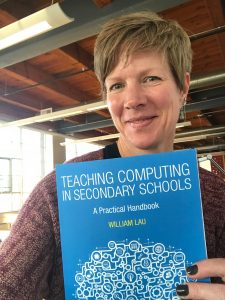Teaching the Power of Computing Through Supportive Guidance
William Lau is a full-time teacher and has young children, but he still found time to write a book about something he’s passionate about–computing instruction.
Lau’s book, “Teaching Computing in Secondary Schools” is a practical handbooks that provides a digestible guide for teachers who want to create a supportive environment for students learning computing.
In college, Lau studied computing and business and then began teaching IT, video editing and graphic design. But his start in the field began the same way it does for many students: In his first computer class at age 10 he remembers feeling incredibly lost. He was so lost, in fact, that when the teacher asked students to shut down their machines at the end of the class, Will pulled the plug out of the wall!
His shame and embarrassment when he realized his mistake was so acute that he vowed to help others not get so lost when learning about the power of computers and what makes them tick.

The approach outlined in Lau’s book approach is user-friendly and assumes no prior knowledge of hardware and software. In fact, when teaching preschoolers and kindergartners, Lau starts off with basics like developing fine motor skills needed to operate a mouse and keyboard. With his methods, it’s possible to teach anyone who wants to learn.
Yet Lau admitted that when teachers are unwilling or being forced to learn about computers, it’s very difficult to help them gain the right skills, much less get their students excited about computing. He recommends that administrators make sure teachers have adequate resources–primarily time–and money.
His advice for teachers who want to learn and teach computing?!
- Develop your own skills
- Focus on student thinking rather than the activities
Unpacking that second idea, he encourages teachers to study how expert computer scientists think, and understand common misconceptions people have as they learn about computing.
Computer science is an incredibly dynamic subject to teach, because it changes every day. One day a teacher may understand mobile app development, and then a new technology like augmented reality emerges. Teachers need to be given time to constantly update their own skills.
How to Stay Up to Date?
Lau follows cognitive scientists and educators like Daniel T Willingham (@DTWillingham) like Greg Ashman (@greg_ashman ), Paul A. Kirschner (@P_A_Kirschner), Joe Kirby (@joe__kirby), and Doug Lemov (@Doug_Lemov) on twitter, where they post their research.
He recommends Python as a starter programming language, especially because there is a robust online community and resources available on pythonprogramming.net, pythonschool.net and youtube.
What Lau Is Into
Lau spends much of his time teaching Advanced Placement Computer Science, and learning about Pygame through Al Sweigart’s books. He feels a strong responsibility to give back to the network of computer science learners by providing research-based mentorship.
Goals for the Future
Lau is passionate about developing a global network of computer science educators, rather than leaving folks siloed in localized computer science communities. For example, we don’t know much about how Russia teaches computer science, but they are graduating top talent into the workforce. Computers are global, why isn’t computer education global?!
You can find William Lau @MrLauLearning on Twitter.
Follow EdWeek Market Brief on Twitter @EdMarketBrief or connect with us on LinkedIn.
Image courtesy of Nikki Navta.
See also:
- 12 Computer Science Resources that Boost Professional Learning
- Advocating for Equity and Inclusion in Computer Science Education
- $195 Million in Federal Grants for STEM, Computer Science Open for Applications
- How Early Is Too Early to Teach Computer Science?
- A Helpful Primer: Sound Smart When Talking About Computer Science
